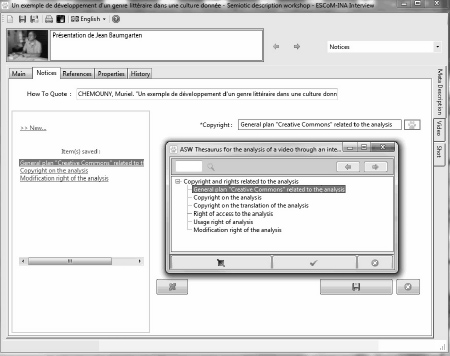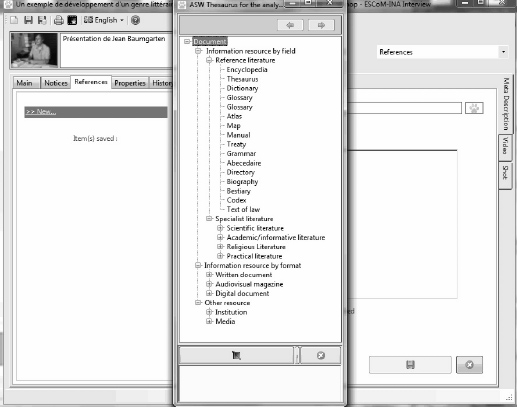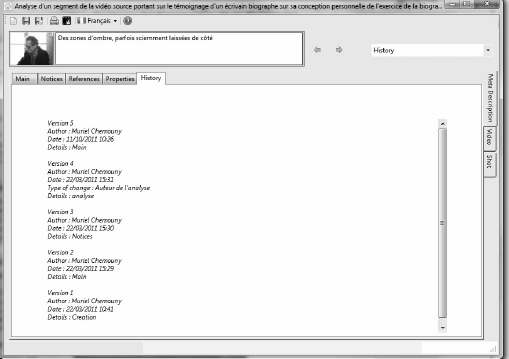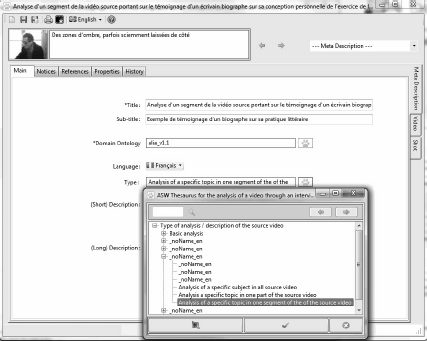Chapter 3
Description Workshop for Audiovisual Corpora 1
3.1. A general overview
As we have just seen, ASW Studio enables us to segment a source video and subsequently describe it. Now let us deal with the phase of analyzing all or part of a video, which is done once it has been segmented.
The Description Workshop constitutes the technical execution and visual expression of the video analysis approach based on the semiotics of the audiovisual document. It offers the possibility of analyzing an audiovisual text with three levels or three headings – the metadescription, the source video in its entirety (without segmentation) and the video segment, as shown in Figure 3.1.
The “Metadescription” tab is reserved for identifying and describing a source video or a segment thereof (author/title of the description, legal notices, etc.).
The “Video” tab deals with the description/analysis of the source video in its entirety as a non-segmented entity.
The “Segment” tab is dedicated to the description of each segment previously identified and cut by the analyst.
Figure 3.1. The three levels of description of the video (in the upper right corner)
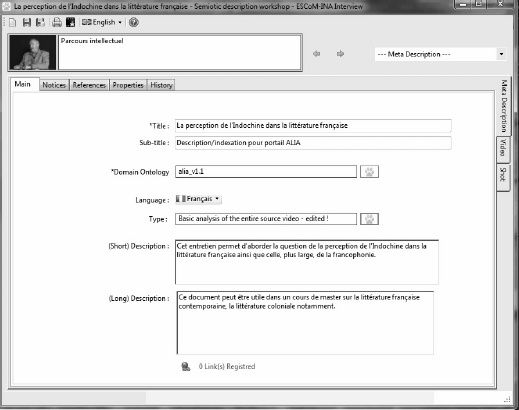
In formal terms, the “Video” and “Segment” tabs have a structure which is built according to a structural model of audiovisual texts, applied at video level for the former, and at segment level for the latter.
Each of these tabs is described and represented by a number of forms to be filled in, enabling us to report on the structural aspects of the larger video and/or one of its segments, i.e. of the audiovisual text. Indeed, the audiovisual document is organized as a “meaningful whole”,1 in the words of Greimas.2 The internal, relational logic, is organized around a number of levels – thematic, narrative, rhetorical, discursive, etc. In the case of an audiovisual document, the visual and acoustic levels may be added to these. The articulation, the relationships between these different levels form a meaningful whole.
3.2. The “metadescription” part of an audiovisual analysis in ASW Studio: the mark of the editor’s choice
This tab is dedicated less to the content per se of a video than to the work of description itself: its objectives, its motives. Here, as well, the contexts for its use are displayed – educational, scientific, journalistic, professional, etc. – and the target audience for the video or segment, which can be placed into categories according to criteria such as age, level of knowledge, socio-professional background.
Metadescription deals either with the work or with the source video in its entirety, unedited, or one or more segments of this source video having been edited beforehand in the Segmentation Workshop.
The analysis of the audiovisual document, the analyst’s angle of approach – which may be either general or targeted (in a thematic, visual, acoustic, discursive, etc. manner) – is closely linked with the publication genre defined beforehand by the analyst, such as an educational or thematic folder, a video-glossary, a narrative passage, a trailer, etc. Note that we dealt with these models of publication, developed as part of R&D projects prior to the ASW-HSS3 project. Hence, when creating a video-glossary on archeology, it may prove interesting e.g. in an interview with an archeologist, to single out the definition of a term: in order to do so, we segment the video in the Segmentation Workshop to extract the definition we are interested in, then we explain the reasons behind that choice in the metadescription, we state why, for what use and for whose use we chose this definition. In this case, the extract may be useful in both formal and informal teaching, be addressed to an all-specialist audience, if the definition relies on notions which are too specialized for an amateur audience. The type of publication for this video extract is a video-glossary. Laid out according to fields of knowledge, the video-glossary contains video extracts which define the names of people, social groups, languages, etc. for the field of knowledge represented by the ARC (CCA)4 experimental workshop; names of disciplines, times and objects, etc. forming part of the field of knowledge represented by the ADA (ArkWork)5 experimental workshop; names of literary streams, genres, schools, artistic practices, etc. belonging to the field of knowledge represented by the ALIA (LHE) experimental workshop.6
Each new editorial choice has a corresponding new metadescription attached to a type of analysis, whether it is the same source video or a segment thereof. For this reasons, there may be several metadescriptions for the same source video or segments(s) corresponding to each type of publication chosen by the analyst. Let us take the example of a report on bread-baking in Portugal.7 The video is made up of interviews with people and passages where we can see the different stages of the bread-making process: a theoretical aspect, on the one hand, a practical one on the other. With the Segmentation Workshop, the analyst chooses to bring the interviews together, outlining his method and objectives in a first metadescription, where he explains that his analysis aims to place the emphasis on the theoretical, historical and sociological ideas of bread and is targeted at students pursuing a master’s degree in ethnology. Then, he creates a second metadescription with the video passages – processed beforehand using the Segmentation Workshop – showing the baking of bread, step by step, the objective being to transmit knowhow which is particular to a culture – in this case, the traditional baking of bread in Portugal – and address it, this time around, to professional bakers in the context of continuing education. A third metadescription regards a stage of bread baking, with the corresponding theoretical and practical passage(s) – a document which may be integrated into a path for discovering the knowledge of the baker’s profession, during a display about bread. Thus we may imagine an infinite variety of uses of the videos.
This example shows that when effecting a metadescription, one has to bear in mind not only the semiotic and cognitive analysis of the source video and the potential exploitation of the whole, but also of the potential exploitation of the audiovisual segments extracted by the analyst, and defined by him.
Consequently, carrying out a metadescription obviously requires a good knowledge of the audiovisual text prior to analysis. Being aware of its cognitive and semiotic content, its genre – research interview, conference, seminar, report, documentary film, “on-location” film, filmed performances, etc. enables us to appreciate the editorial choice which may be attributed to it.
3.2.1. General overview
The metadescription tab comprises five subsections – General, Citations, References, Properties, History – the interfaces for some of which are presented as forms for description/indexing (see Figure 3.3):
Figure 3.3. The metadescription (general) interface

3.2.1.1. General
The Metadescription heading opens with the General sub-heading showing. In order to present its main features without going into too much detail, which shall be developed in the next section, this tab comprises a general title and a subtitle, as seen in Figure 3.3. Then, the domain of knowledge to which it refers enables us to indicate the domain ontology, i.e. the metalanguage peculiar to the domain of knowledge which corresponds to this metadescription: the cultures and languages of the world for the CCA domain of knowledge, archeology for ArkWork and literature for the LHE domain of knowledge.
Apart from these three domains of knowledge developed in the ASW-HSS project, two new ones were recently added: the audiovisual archives dedicated to the intangible heritage of the Andean populations in Peru and Bolivia,8 and one on the cultural heritage of Azerbaijan.9 In the next few months, other domains will be added to those already in place, since the list is perfectly open to modification. It corresponds to the diversity of the user “communities” which set up their own archives or video-libraries using ASW Studio.
Once the choice of the domain ontology has been made, we must indicate the language in which the metadescription is written and the genre of analysis of the video, selected from a number of options: “basic analysis” of the video, segmented or otherwise; “in-depth analysis” of the video in its entirety, or one or more segments thereof. Finally, a particular box is provided for a short summary characterizing the analysis/description of the audiovisual document as well as a detailed presentation of the content and its objectives, specifying the uses and audiences for which the final product is intended.
3.2.1.2. Citations
The second tab, Citations, is given over firstly to the specification of the various rights attached to the analysis and its use, and secondly to defining the way in which the description must be cited.10 In terms of the rights associated with the description, the default setting adopted as part of the ASW-HSS project – the aim of which, it should be noted, is not to focus on issues of the rights relating to digital resources – is that of Creative Commons.11
These rights correspond to the legal citations, the copyright relating to the analysis, the author, the person responsible for the analysis, the translator of the analysis. As for rights concerning the usage to which the analysis is put – modification, use – the legal formula states that the author’s permission must be obtained before modifying or using the content.12 In addition the author and/or analyst may, if they so desire, determine certain conditions of access and specify them in a box reserved for this purpose.
Let us note, in addition, that the various rights relating to the description again constitute a controlled vocabulary, integrated into the metalinguistic resources of the Description Workshop. One important point on this issue is the possibility of making it evolve, complementing it, adapting it, according to the needs of the analyst and/or institution, the community he/she works for.
3.2.1.3. References
The third subsection, References, shows the digital and/or paper documents which the analyst used to structure and feed his analysis in view of a specialized publication (educational folders, lessons, themed folders, etc.). Here, we can provide links to the Websites of relevant institutions, or general works such as “dictionaries”, didactic literature, etc. which may be consulted. Three main categories of references were identified, developed for the ASW-HSS project, and integrated into the ASW thesaurus. Note that they are modifiable and adaptable to the particular constraints or specificities of a given user community.
These three categories are distributed as follows:
– documentary resources by genre: these are references to general “didactic” books (such as dictionaries, encyclopedias, atlases, textbooks, etc.), so-called “gray” literature (dissertations, research reports, etc.) or documents of interest from a pedagogical point of view;
– documentary resources by type of communication: this category brings together all documentary resources stemming from oral communication (conferences, interviews, lessons, etc.), printed and audiovisual media (the general and specialist press, television, radio, film and video) and intrinsically digital media;
– finally, a category of references made up of non-documentary supports, e.g. references to institutions (for example, to such-and-such a research lab, museum, documentation center, etc.).
In order to compile an educational folder dedicated to the theme of the Arabian Nights tales, intended for the LHE workshop, we drew inspiration from those offered on the Website of the Centre National de Documentation Pédagogique (CNDP, French National Educational Information Center).13 This Website of educational and documentary resources, at the head of the SCEREN national network (Service Culture, Editions, Ressources pour l’Education Nationale – National Service of Culture, Publications and Resources for Education)14 offers folders about the tales, in particular the animated movie by Michel Ocelot (2006), Azur and Asmar: The Princes’ Quest.15 There, we found general elements for interpreting the tales and gleaned a number of ideas on how to use an audiovisual document.
3.2.1.4. Properties and history
The last two subsections making up the Metadescription, i.e. Properties and History, automatically give information on the analyst’s and the history of his activities.
As we can see in Figure 3.6, the Properties tab gives the identifier of the analysis, the version number of the analysis, its creation date with the name of the author and the date it was last modified.
The History automatically shows the details of the interventions, numbered, with the name and role of the analyst – author, person in charge, translator, etc. – the dates and times of the different interventions and the task carried out during each of these. Before saving his analysis, translation, etc. The intervening person is free to specify, or not, the details of his indexing, description work in the different fields.
Figure 3.6. The properties tab
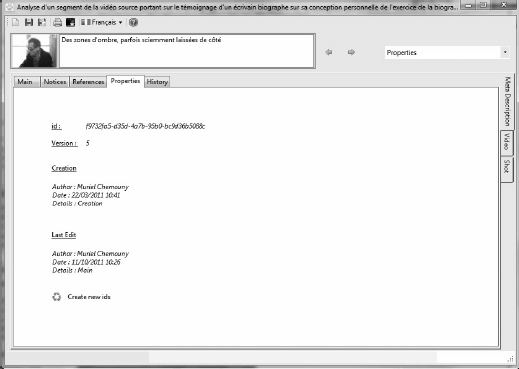
3.2.2. Focus on the “general” sub-section of metadescription
Let us look at the General sub-section, a view of which is provided in Figure 3.1 in greater detail. As the figure shows, this sub-section brings together a set of data essential to any analysis, such as the title of the metadescription, the choice of the language used to write it, and a box for two presentations – one brief, one longer – of the content of the metadescription.
The compulsory title of the metadescription must to be explicit enough to give an idea of the object, its angle of approach, the type of analysis or description of the audiovisual document and the topic dealt with. First of all, however, it is appropriate to determine the domain of knowledge to which the analysis corresponds, in order to access the most appropriate metalinguistic resources, called domain “ontologies”.
By the term “domain ontology” we understand a set of metalinguistic resources made available to the analyst in order to process and analyze a specific field of knowledge. In the context of the ASW-HSS project, in particular it is archeology (ArkWork experimental workshop), world cultures (CCA experimental workshop) and literature (LHE experimental workshop) which are dealt with. The analyst chooses the domain ontology he needs for his analysis as soon as the Description Workshop opens. Hence, he accesses a whole range of metalinguistic resources that the ASW environment makes available to him: description scenarios, thesaurus, external references to terminology, to usual norms such as LOMFR, etc.
3.2.2.1. The types of analysis
Whatever the source video, the analyst may choose to describe it in its entirety or to isolate relevant parts in accordance with his initial editorial choice.
Of course, the editorial choice expressed in the metadescription determines the sequential processing of the video – the “virtual cutting” of it – and the type of analysis.
We have defined several sorts of analyses of a video in the context of the ASW-HSS project, some of which begin from an uncut video, other from cut videos. These different types may be more or less in-depth; they may also focus on a theme, or analyze the image and/or sound.
Hence, as regards processing a complete video, the basic analysis of the unsegmented source video, corresponds approximately to a library/archiving type of description. Only the bare minimum of parameters which are essential at the level of the analysis itself and at the level of the audiovisual document, are displayed. A second type of unsegmented analysis is the In-depth analysis of the unsegmented source video which implies a work of expertise on the video content in its entirety but without segmentation. This type of analysis is found with relatively short video clips for which segmentation does not seem useful.
The second category of analyses is those carried out based on an audiovisual document which was segmented to begin with or a video cut by the analyst using the Segmentation Workshop (see Chapter 2) for his own specific needs. This is an analysis of the video as a whole, i.e. the entirety of the video cut by the analyst into as many segments as he deems necessary. It comprises the general parameters of basic analysis without segmentation, plus a short, single-sentence description of each segment, accompanied by a longer description in a short section.
The following types of analyses only deal with extracts from the video which were taken from a thematic, visual, acoustic or even iconic angle. They are: Analysis of a part of the video, i.e. a few extracts from the source video; Analysis of a single segment from the source video, i.e. a single sequence identified and cut by the analyst; Analysis of a specific topic from the source video, i.e. a single theme developed in the video in one segment, several segments or throughout the whole video, given that a source video can, of course, develop several topics; Analysis of the visual objects of the source video, i.e. of the objects lato sensu (situations, people, artifacts, natural objects, places, etc.) forming the visual plane of the source video; Analysis of the acoustic objects of the source video, i.e. lyrics, music, noises etc. forming the sound plane of the source video; and finally Iconic and figurative analysis of the source video, i.e. of the “connotative” , “noetic”… meaning of the filmed scenes which make up the source video.
The final category of analysis regards linguistic adaptations, translations. It should be pointed out that the same criteria as we have just defined for the other analyses apply to this category as well.
Each of these analyses uses the Description Workshop in its own specific way, the details of which are explained in the ASW Studio user guide. Any analysis is conditioned by the type of publication in question.
Concretely, of these different categories of analyses, in the ASW-HSS project we have favored either analysis of a complete video with an index making its general content accessible, or of the cut video, with a selection of segments dealing with the same theme.
3.2.2.2. The editorial choice: target audience and uses
Even though the two processes – of analyzing and of publishing an audiovisual resource – are clearly distinct in the ASW-HSS project, the metadescription can constitute a fact sheet on the possible use of the analyzed audiovisual document.
Any raw audiovisual document is, to begin with, explicitly or implicitly destined for a given use and context of exploitation, for a specific social practice (education, research, continuous education, lifelong learning, etc.). However, anyone who undertakes the description of a video may choose to keep to these initial criteria or to modify or adapt them according to his editorial choice.
If the original use or context of exploitation of the video changes, it may prove necessary to carry out an adaptation of it – a thematic, narrative, rhetorical and/or discursive rewriting of the content so as to target it at a given audience, in view of a given publication.
Hence, in the case of a scientific research interview, e.g. if the analyst wishes to share the minute details of its content with a wider audience than just the scientific community, he must adapt the text and create a sort of “popular science” version of it. Of course, the analyst may himself very well be an expert in the same field the scientist being interviewed or even a specialized journalist, a student, etc.
Although, in the ASW-HSS project, there is a clear emphasis on the pedagogical use of a video as part of teaching and learning/training in the broadest sense of the term, other types of uses are not precluded – e.g. communication and/or specific valorization, long-term archiving, etc.
In order to facilitate and give suggestions for using the videos, several model usage scenarios have been developed as part of the ASW-HSS project considering criteria such as the levels of knowledge, ages, socio-professional categories … These models are ideas, examples, and any analyst is free to produce his own usage scenario adapted to his needs and add it to the metadescription. Concrete examples of usage scenarios are developed in detail in Chapter 6 of this book.
3.3. The “identifying information of an audiovisual resource” part in the ASW description workshop
In the previous chapter, we examined the characteristics and advantages peculiar to the metadescription.
The part we shall now concentrate on is devoted to the sections of the software relating to the video itself as opposed to its analysis – more specifically to the general, synthetic indications linked with the audiovisual documents, called “identifying information”. The two interfaces for describing a video in its entirety and describing one of its segments rely on the same analytical criteria based on the semiotic theory of audiovisual texts. This is why the same headings and subheadings can be found at both these levels.
They are grouped under four subheadings, which must be distinguished from the other subheadings specifically dedicated to the semiotic description of the video or segment, and from the common headings to which Chapter 4 of this book is devoted. These are the General, Citations, Classification and Authors tabs.
Similarly to the metadescription interface, the interface of headings attached to the video opens on General. The information provided here refers only to the video and/or segment: title, subtitle, language(s) present in the document, genre – to be chosen from the list of general categories of film documents – interview, lecture, conference, art exhibition, personal/private film – visual documents and sound documents. Also shown are the date and place the video was shot. Two descriptions – one short, one long – outline the document’s content.
Let us take the example shown in Figure 3.9. The analysis deals with a film text about a city – here, more specifically, daily life in Hong Kong – entitled “The city of Hong Kong. An audiovisual documentation of daily life”. The date indicates that the video was shot on 9 April 2007 on site. For the general information, a short description is sufficient. The core of the description is done at the level of the thematic, visual and sound shots, for which it is important to go into depth because of the manifest richness of their content.
Figure 3.9. “Identifying information”: the general subsection
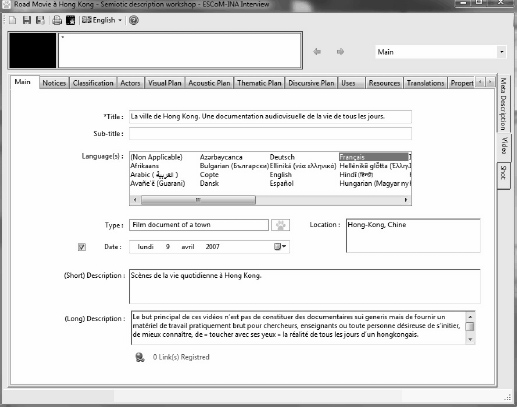
Apart from the General information, at the level of the video we find two subheadings concerning the Actors – be they mere participants, author, director, producer, etc. and Citations, which relates to the legal rights, associated in this case with the video as opposed to its analysis. The rights relating to the video depend, as in the case of the metadescription, on the Creative Commons16 system. The rights apply to the source video, its translation, production, etc.17
Figure 3.10. View of the actors sub-heading of the video and/or segment
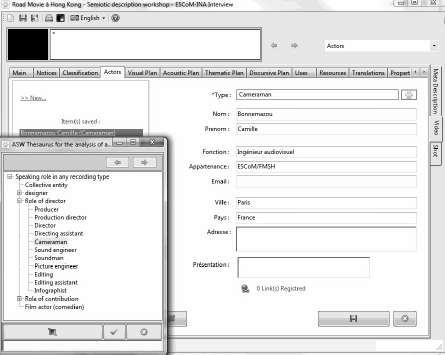
From the Actors sub-section of the video, it is possible to access files serving to index and identify any person or group which had a role of conception, direction or contribution to the video, and to provide information about their function, the institution to which they belong, etc. The choice of the “actors” is made from a list – forming an ASW controlled vocabulary (also ASW micro-thesaurus) – as shown in Figure 3.10.
We have deliberately set apart the last general video sub-sections. Indeed, the Classification interface gives access to an initial basic indexing of the video content by main domains of knowledge related to scientific research such as human and social sciences, formal sciences, natural sciences, health sciences, engineering sciences, natural resource sciences … Apart from these main domains of knowledge, it is possible to index the video according to its social domain: artistic and literary, religious, media-related, economic, political etc. domains.
Three other possibilities of basic indexing are also offered: by education and cultural practices, natural languages and families of languages, geographical classification by regions and countries of the world, and finally by historical eras, ranging from prehistory through to today. The indexing is done using the ASW thesaurus (see Chapter 5) and automatically appears on the left of the form (see Figure 3.11).
Figure 3.11. The classification sub-section
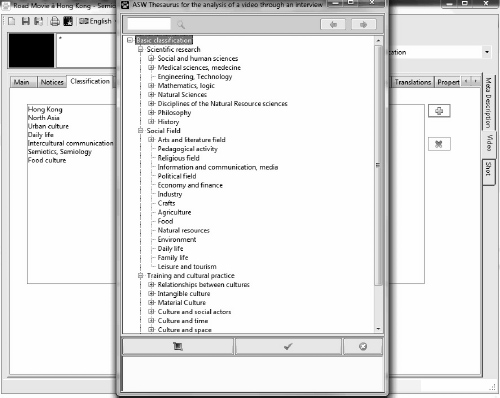
The example of Hong Kong, presented in Figure 3.11, shows this initial overall classification. It gives the following information: “ Northern Asia”, “Hong Kong”, “urban culture”, “daily culture”, “daily life”, “intercultural communication”, “semiotics”, “food-related culture”.
These initial pieces of information on the video are complemented and enriched by the indexing and descriptions made at the level of the different planes: thematic, discursive, visual and sound. These questions will be touched upon in Chapters 4, 5 and 6 of this book.
The identifying information provides initial, general identification, description and indexing for the audiovisual document.
1 Chapter written by Muriel CHEMOUNY.
1 See [STO 01], Lesson I: The audiovisual documentary film in the sense of a “meaningful whole”, at: http://www.semionet.fr/ressources_enligne/Enseignement/00_01/00_01_crim/cours/Cours%20I.pdf.
2 See [GRE 93].
3 Specifically, we refer here to the French research project SAPHIR (2006–2009, spearheaded by INA-Recherche and financially backed by the ANR), and the European research project LOGOS (2006–2009, led by Antenna Hungária and financed by the EC as part of its 6th CORDIS). At the occasion of these projects, models of indexing and (re)-publishing of audiovisual corpora which were serving as a reference to the research and development work for the current ASW-HSS project. For more information about these projects, see the Website of the ESCoM [Semiotic and New Medias Team]: http://www.semionet.fr.
4 “ARC” is the acronym for “Archives Rencontre des Cultures”, which can be translated as “Culture Crossroads Archive” (CCA): http://semioweb.msh-paris.fr/corpus/Arc/FR/.
5 “ADA” is the acronym for “Atelier des Arkéonautes” [Arkeonauts’ workshop (ArkWork)]: http://semioweb.msh-paris.fr/corpus/ADA/FR/.
6 “ALIA” is the acronym for “Atelier Littéraire d’Ici et d’Ailleurs” [Workshop of Literature from Here and Elsewhere (LHE)]: http://semioweb.msh-paris.fr/corpus/ALIA/FR/.
7 This audiovisual report on “Home-baking of bread in Portugal” can be viewed online at the following two addresses: on the ARA Website: http://www.archivesaudiovisuelles.fr/1895/; and on the Website of the CCA workshop: http://semioweb.msh-paris.fr/corpus/arc/1970.
10 The suggested format is based on the following scheme: SURNAME, forename. “Title of the description”. Type of analysis of such source video (title), year of analysis, name of the workshop (acronym), reference number for the source video on the workshop-site, year of the source video [online]; URL address of the video or segment. Example: CHEMOUNY, Muriel. “Description of a segment about the virtual meeting between two Provencal writers”. Analysis of a single sequence of the source video “Roman linguistics, Occitan language and literature”, 2010, LHE, no 2002, 2006 [online]; RL: http://semioweb.msh-paris.fr/corpus/ALIA/2002 See University of Laval Website: http://www.bibl.ulaval.ca/doelec/doelec29.html.
11 “Creative Commons – Paternity – Not for Commercial Use- No Modification 2.0 France”. This audiovisual resource is protected by a “Creative Common” license. You are free to reproduce, distribute and communicate it to an audience. However you must imperatively signal its paternity (its author(s)), you are not allowed to modify it, neither are you allowed to make commercial use of this resource. Playing, diffusion and concrete exploitation of this audiovisual resource presuppose that you have accepted the Creative Commons legal rules described at http://creativecommons.org/licenses/by-nc-nd/2.0/fr/.
12 No modification of the content of this analysis may be made without the consent of its author. To apply for authorization to modify its content, please contact: Forename, Surname, Institution, Address.
13 The site can be accessed at the following address: http://www.cndp.fr.
14 This network is presented on the Website, at: http://www2.cndp.fr/cndp_reseau/presentation/accueil.htm.
15 See the file on the CNDP site at: http://www2.cndp.fr/actualites/question/azurasmar/accueil-Imp.htm.
16 The formula differs from the one for analysis (see Footnote 7, this chapter) since it relates to the video. “This audiovisual resource is protected by the Creative Commons system. You are free to reproduce, distribute and communicate it publicly. However, you must indicate its paternity (its author(s)). You do not have the right to modify it, nor make commercial use of it. Playing, distribution and concrete exploitation of this audiovisual resource presupposes that you have accepted the legal regulations of Creative Commons, described at http://creativecommons.org/licenses/by-nc-nd/2.0/fr/”.
17 The wording is made using the following model, to be modified depending on whether it is a person or a group or an institution, or the ESCoM team: “The author (the authors) of this audiovisual resource (audiovisual documentary, audiovisual record, etc.) is/are: SURNAME Forename (Institution, Place and Date)”.


